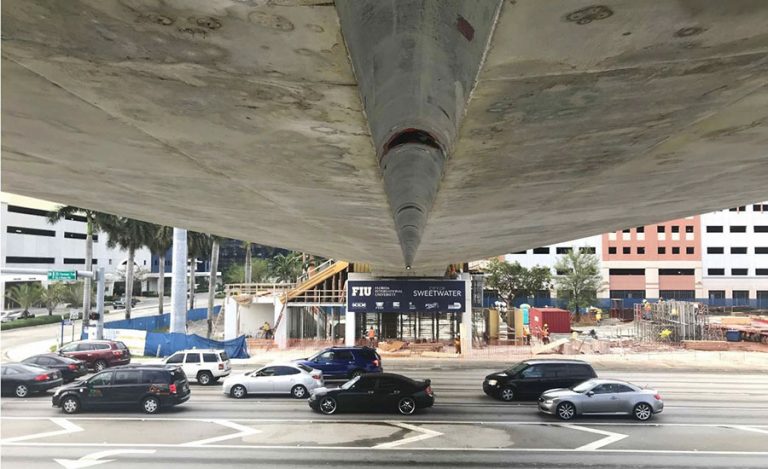
The National Transportation Safety Board (NTSB) says it will release its final report on Oct. 22 relating to the deadly Florida International University (FIU) bridge collapse on March 15, 2018.
Ahead of this release, the NTSB on Oct. 8 released several documents, which Engineering News-Record (ENR) reports say raise “questions but provides no definitive conclusions about why the partially built structure suddenly crashed to the ground,” killing six.
Among the Oct. 8 release are interview transcripts, newly released photos and dozens of other items are two separate reports submitted by the project’s lead contractor, MCM, and the bridge’s design engineer, FIGG Bridge Engineers.
The respective “party submission” reports, provided to NTSB as part of the agency’s investigatory process, offer dueling accounts, with each pointing responsibility at the other party, ENR reports.
FIGG asserts that contractors failed to communicate specifics of cracking on the bridge structure.
For example, FIGG asserts that contractors failed to communicate specifics of cracking on the bridge structure. MCM’s report to NTSB counters that argument with details of emails and other communications to FIGG—and other project team members—noting the cracking’s severity.
In an Oct. 8 press release, FIGG asserted that the conclusions reached by Wiss, Janney, Elstner Associates (WJE), whom FIGG hired, that the collapse resulted from “a failure by contractors to conform to the final bridge design plans and comply with state of Florida construction requirements.”
The Tallahassee-based bridge engineer specified that the “probable cause,” based upon WJE’s findings, was that “the construction joint at the north end of the main span between the truss members and the bridge deck was not roughened as required.”
“This failure to meet the construction specification requirements was not noticed by either the contractor’s quality control personnel or by the construction inspectors under contract to FIU,” FIGG said in its statement.
FIGG asserts that MCM and other firms on site had become aware of changes in the cracks that were occurring on the bridge in the days preceding the collapse, but failed to communicate these developments to FIGG personnel.
“There is no indication that MCM, BPA (Bolton, Perez & Associates) or other project participants who were on-site during this time actively observing the cracking expressed concern with the safety of the span suspended over SW 8th Street or suggested that the road should be closed until the situation was resolved,” FIGG’s report states.
However, MCM provides its own interpretation in its statement to the NTSB, which reportedly rebuts FIGG’s version of events with extensive details of its communications to the bridge designer.
For example, days before the collapse, MCM reports emailing new photos of the cracking to FIGG, along with this message: “Following our previous emails regarding the noted cracks, and as witnessed on site by FIGG as part of the movement/erection support, attached please find photos depicting the cracks developed prior [to] and post [of] the span 1 erection and/or destressing of truss members 2 and 11, ENR reports.
“It is our opinion that some of these cracks are rather large and/or of concern; therefore, please review and comment as promptly as possible and advise if there is a required course of action to remedy or address these right away,” MCM says in its email.
MCM further asserts to NTSB that FIGG’s design manager, Dwight Dempsey, communicated back to the contractor that the engineer “did not see this as a safety issue.”
ENR reports that minutes of a FIGG-led meeting held on-site the morning of the collapse, released by FDOT in May, back up MCM’s contention that the bridge’s designers saw “no safety concern” from the cracks. The record of that March 15 meeting showed, for example, that a slide from FIGG’s presentation stated: “After about an hour of review and evaluation, FIGG had conducted sufficient supplemental/independent computations to conclude that there is not any concern with safety of the span suspended over the road.”
However, citing the analysis by WJE, FIGG contends that the blame rests squarely with construction contractors, stating: “Contrary to incomplete prior accident updates, the design of the UniversityCity Pedestrian Bridge at Florida International University was neither the proximate cause, nor a contributing cause, of the construction accident. If, however, the various parties constructing the bridge, inspecting the construction, or moving the bridge into position, fail to comply with (plans, specifications, and requirements), then even a safe design will be compromised.”
The NTSB will release its probable cause report at 9:30 a.m. on Oct. 22 at a public meeting, which will be available by live webcast.